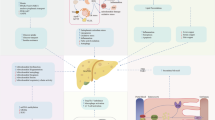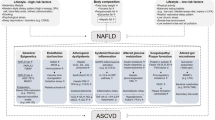Abstract
Several novel circulating adipokines are associated with insulin resistance and inflammation. Little information exists in NAFLD about three recently recognized adipokines lipocalin-2, cathepsin S and chemerin. To assess the relationship between serum lipocalin-2, cathepsin S and chemerin levels and the development of non-alcoholic fatty liver in Chinese subjects, we measured serum lipocalin-2, cathepsin S and chemerin levels in 903 Chinese subjects by ELISA. Among the study population, 436 patients are with B-mode ultrasound-proven NAFLD and 467 controls. Levels of lipocalin-2, but not cathepsin S and chemerin, were significantly elevated in NAFLD versus control [lipocalin-2, 89.67 ± 4.47 vs. 68.70 ± 3.65 ng/mL (p < 0.001)]. After stepwise linear regression analysis adjusting for potential cofounders, further revealed that serum lipocalcin-2 was an independent predictor of NAFLD in whole cohort (standardized β = 0.114, t = 2.347, p = 0.02). Lipocalin-2 levels correlated with insulin resistance (homeostasis model assessment of insulin resistance) and inflammation (CRP) in whole cohorts and NAFLD, whereas cathepsin S and chemerin only correlated positively with insulin resistance and inflammation in whole cohorts. Our results indicated that circulating lipocalin-2, produced by adipocytes, are elevated and may contribute to the development of NAFLD. Serum lipocalin-2, which correlates with inflammation and insulin resistance, may have a direct pathogenic link to disease progression.

Similar content being viewed by others
References
Zelber-Sagi S, Nitzan-Kaluski D, Halpern Z, Oren R (2006) Prevalence of primary non-alcoholic fatty liver disease in a population-based study and its association with biochemical and anthropometric measures. Liver Int 26:856–863
Musso G, Gambino R, Cassader M (2010) Non-alcoholic fatty liver disease from pathogenesis to management: an update. Obes Rev 11:430–445
Musso G, Gambino R, Cassader M, Pagano G (2011) Meta-analysis: natural history of non-alcoholic fatty liver disease (NAFLD) and diagnostic accuracy of non-invasive tests for liver disease severity. Ann Med 43:617–649
Feldstein AE (2010) Novel insights into the pathophysiology of nonalcoholic fatty liver disease. Semin Liver Dis 30:391–401
van der Poorten D, Milner KL, Hui J, Hodge A, Trenell MI, Kench JG, London R, Peduto T, Chisholm DJ, George J (2008) Visceral fat: a key mediator of steatohepatitis in metabolic liver disease. Hepatology 48:449–457
Shoelson SE, Herrero L, Naaz A (2007) Obesity, inflammation, and insulin resistance. Gastroenterology 132:2169–2180
Jin D, Guo H, Bu SY, Zhang Y, Hannaford J, Mashek DG, Chen X (2011) Lipocalin 2 is a selective modulator of peroxisome proliferator-activated receptor-gamma activation and function in lipid homeostasis and energy expenditure. FASEB J 25:754–764
Guo H, Jin D, Zhang Y, Wright W, Bazuine M, Brockman DA, Bernlohr DA, Chen X (2010) Lipocalin-2 deficiency impairs thermogenesis and potentiates diet-induced insulin resistance in mice. Diabetes 59:1376–1385
Wang Y, Lam KS, Kraegen EW, Sweeney G, Zhang J, Tso AW, Chow WS, Wat NM, Xu JY, Hoo RL, Xu A (2007) Lipocalin-2 is an inflammatory marker closely associated with obesity, insulin resistance, and hyperglycemia in humans. Clin Chem 53:34–41
Chapman HA, Riese RJ, Shi GP (1997) Emerging roles for cysteine proteases in human biology. Annu Rev Physiol 59:63–88
Petanceska S, Canoll P, Devi LA (1996) Expression of rat cathepsin S in phagocytic cells. J Biol Chem 271:4403–4409
Taleb S, Lacasa D, Bastard JP, Poitou C, Cancello R, Pelloux V, Viguerie N, Benis A, Zucker JD, Bouillot JL, Coussieu C, Basdevant A, Langin D, Clement K (2005) Cathepsin S, a novel biomarker of adiposity: relevance to atherogenesis. FASEB J 19:1540–1542
Roh SG, Song SH, Choi KC, Katoh K, Wittamer V, Parmentier M, Sasaki S (2007) Chemerin–a new adipokine that modulates adipogenesis via its own receptor. Biochem Biophys Res Commun 362:1013–1018
Kukla M, Zwirska-Korczala K, Hartleb M, Waluga M, Chwist A, Kajor M, Ciupinska-Kajor M, Berdowska A, Wozniak-Grygiel E, Buldak R (2010) Serum chemerin and vaspin in non-alcoholic fatty liver disease. Scand J Gastroenterol 45:235–242
Sell H, Divoux A, Poitou C, Basdevant A, Bouillot JL, Bedossa P, Tordjman J, Eckel J, Clément K (2010) Chemerin correlates with markers for fatty liver in morbidly obese patients and strongly decreases after weight loss induced by bariatric surgery. J Clin Endocrinol Metab 95:2892–2896
Huang Y, Yang Z, Ye Z, Li Q, Wen J, Tao X, Chen L, He M, Wang X, Lu B, Zhang Z, Zhang W, Qu S, Hu R (2012) Lipocalin-2, glucose metabolism and chronic low-grade systemic inflammation in Chinese people. Cardiovasc Diabetol 11:11
Yang Z, Wang X, Wen J, Ye Z, Li Q, He M, Lu B, Ling C, Wu S, Hu R (2011) Prevalence of non-alcoholic fatty liver disease and its relation to hypoadiponectinaemia in the middle-aged and elderly Chinese population. Arch Med Sci 7:665–672
Lu B, Yang Z, Wang M, Yang Z, Gong W, Yang Y, Wen J, Zhang Z, Zhao N, Zhu X, Hu R (2007) High prevalence of albuminuria in population-based patients diagnosed with type 2 diabetes in the Shanghai downtown. Diabetes Res Clin Pract 75:184–192
Yang Z, Zhang Z, Wen J, Wang X, Lu B, Yang Z, Zhang W, Wang M, Feng X, Ling C, Wu S, Hu R (2010) Elevated serum chemokine CXC ligand 5 levels are associated with hypercholesterolemia but not a worsening of insulin resistance in Chinese people. J Clin Endocrinol Metab 95:3926–3932
Milner KL, van der Poorten D, Xu A, Bugianesi E, Kench JG, Lam KS, Chisholm DJ, George J (2009) Adipocyte fatty acid binding protein levels relate to inflammation and fibrosis in nonalcoholic fatty liver disease. Hepatology 49:1926–1934
Law IK, Xu A, Lam KS, Berger T, Mak TW, Vanhoutte PM, Liu JT, Sweeney G, Zhou M, Yang B, Wang Y (2010) Lipocalin-2 deficiency attenuates insulin resistance associated with aging and obesity. Diabetes 59:872–882
Esteve E, Ricart W, Fernández-Real JM (2009) Adipocytokines and insulin resistance: the possible role of lipocalin-2, retinol binding protein-4, and adiponectin. Diabetes Care 32(Suppl 2):362–367
Byrne CD, Olufadi R, Bruce KD, Cagampang FR, Ahmed MH (2009) Metabolic disturbances in non-alcoholic fatty liver disease. Clin Sci (Lond) 116:539–564
Playford RJ, Belo A, Poulsom R, Fitzgerald AJ, Harris K, Pawluczyk I, Ryon J, Darby T, Nilsen-Hamilton M, Ghosh S, Marchbank T (2006) Effects of mouse and human lipocalin homologues 24p3/lcn2 and neutrophil gelatinase-associated lipocalin on gastrointestinal mucosal integrity and repair. Gastroenterology 131:809–817
Miele L, Valenza V, La Torre G, Montalto M, Cammarota G, Ricci R, Mascianà R, Forgione A, Gabrieli ML, Perotti G, Vecchio FM, Rapaccini G, Gasbarrini G, Day CP, Grieco A (2009) Increased intestinal permeability and tight junction alterations in nonalcoholic fatty liver disease. Hepatology 49:1877–1887
Magister S, Obermajer N, Mirković B, Svajger U, Renko M, Softić A, Romih R, Colbert JD, Watts C, Kos J (2012) Regulation of cathepsins S and L by cystatin F during maturation of dendritic cells. Eur J Cell Biol 91:391–401
Naour N, Rouault C, Fellahi S, Lavoie ME, Poitou C, Keophiphath M, Eberlé D, Shoelson S, Rizkalla S, Bastard JP, Rabasa-Lhoret R, Clément K, Guerre-Millo M (2010) Cathepsins in human obesity: changes in energy balance predominantly affect cathepsin s in adipose tissue and in circulation. J Clin Endocrinol Metab 95:1861–1868
Pan L, Li Y, Jia L, Qin Y, Qi G, Cheng J, Qi Y, Li H, Du J (2012) Cathepsin S deficiency results in abnormal accumulation of autophagosomes in macrophages and enhances Ang II-induced cardiac inflammation. PLoS One 7:e35315
Jobs E, Risérus U, Ingelsson E, Helmersson J, Nerpin E, Jobs M, Sundström J, Lind L, Larsson A, Basu S, Arnlöv J (2010) Serum cathepsin S is associated with serum C-reactive protein and interleukin-6 independently of obesity in elderly men. J Clin Endocrinol Metab 95:4460–4464
Yang Z, Wen J, Li Q, Tao X, Ye Z, He M, Zhang W, Huang Y, Chen L, Ling C, Qu S, Hu R (2012) PPARG gene Pro12Ala variant contributes to the development of non-alcoholic fatty liver in middle-aged and older Chinese population. Mol Cell Endocrinol 348:255–259
Yang Z, Wen J, Tao X, Lu B, Du Y, Wang M, Wang X, Zhang W, Gong W, Ling C, Wu S, Hu R (2010) Genetic variation in the GCKR gene is associated with non-alcoholic fatty liver disease in Chinese people. Mol Biol Rep 38:1145–1150
Meder W, Wendland M, Busmann A, Kutzleb C, Spodsberg N, John H, Richter R, Schleuder D, Meyer M, Forssmann WG (2003) Characterization of human circulating TIG2 as a ligand for the orphan receptor ChemR23. FEBS Lett 555:495–499
Weigert J, Neumeier M, Wanninger J, Filarsky M, Bauer S, Wiest R, Farkas S, Scherer MN, Schäffler A, Aslanidis C, Schölmerich J, Buechler C (2010) Systemic chemerin is related to inflammation rather than obesity in type 2 diabetes. Clin Endocrinol (Oxf) 72:342–348
Bozaoglu K, Bolton K, McMillan J, Zimmet P, Jowett J, Collier G, Walder K, Segal D (2007) Chemerin is a novel adipokine associated with obesity and metabolic syndrome. Endocrinology 148:4687–4694
Ernst MC, Sinal CJ (2010) Chemerin: at the crossroads of inflammation and obesity. Trends Endocrinol Metab 21:660–667
Parlee SD, Ernst MC, Muruganandan S, Sinal CJ, Goralski KB (2010) Serum chemerin levels vary with time of day and are modified by obesity and tumor necrosis factor-{alpha}. Endocrinology 151:2590–2602
Stejskal D, Karpisek M, Hanulova Z, Svestak M (2008) Chemerin is an independent marker of the metabolic syndrome in a Caucasian population–a pilot study. Biomed Pap Med Fac Univ Palacky Olomouc Czech Repub 152:217–221
Yilmaz Y, Yonal O, Kurt R, Alahdab YO, Eren F, Ozdogan O, Celikel CA, Imeryuz N, Kalayci C, Avsar E (2011) Serum levels of omentin, chemerin and adipsin in patients with biopsy-proven nonalcoholic fatty liver disease. Scand J Gastroenterol 46:91–97
Acknowledgments
This work was supported by the National Natural Science Foundation of China (81000344, 81030014), Shanghai Science and Technology Commission (08dj1400605, 08JC1403200, 09DZ1950200), China Postdoctoral Science Foundation (20080440078), and Shanghai Postdoctoral Scientific Program (09R21411600).
Conflict of interest
The authors declare that they have no competing interest.
Author information
Authors and Affiliations
Corresponding author
Additional information
Zi Ye and Suijun Wang have contributed equally to this work.
Rights and permissions
About this article
Cite this article
Ye, Z., Wang, S., Yang, Z. et al. Serum lipocalin-2, cathepsin S and chemerin levels and nonalcoholic fatty liver disease. Mol Biol Rep 41, 1317–1323 (2014). https://doi.org/10.1007/s11033-013-2977-5
Received:
Accepted:
Published:
Issue Date:
DOI: https://doi.org/10.1007/s11033-013-2977-5




